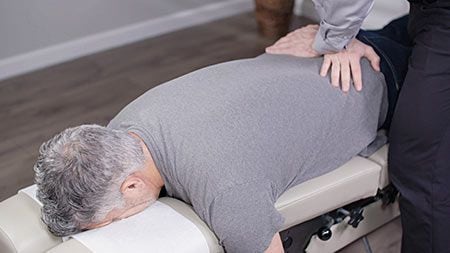Our spine does a lot of heavy lifting. It is the structure that holds us up, lets us move and protects the spinal cord. When the spine isn’t operating as well as it could, the result is often back pain. Back pain is the number one reason people miss work, and more than three quarters of us will experience it in our lifetime. Chiropractic care can help keep your spine and back healthy and functioning smoothly, so you can get on with your daily routine.
The spine and back form a complex anatomical design. The spine is a series of interlocking vertebrae, bones that form joints cushioned by rubbery discs. Nerve roots from the spinal cord branch out through the spine to send signals back and forth between all parts of the body and the brain. Ligaments, muscles, tendons and fascia (connective tissue beneath the skin) interact to support the spine and let us sit, stand, walk and run.
Unfortunately, things can go wrong with any of these components. You can sprain ligaments, strain muscles or rupture disks. Spinal joints can move out of position or lose their flexibility. Nerves can become irritated and inflamed. Fascia can develop painful knots. Bad posture, scoliosis (curvature of the spine) and obesity are also common contributors to back pain.
How Chiropractors Treat Back Pain
Chiropractors specialize in treating mechanical disorders of the musculoskeletal system, especially the spine. They train for years to understand the complex relationships between the structures of the back and how they can affect the rest of your body.

When you have an initial appointment with a chiropractor, they will take a medical history and ask about your daily routine to assess whether any of your regular activities might be contributing to your back pain. It could be poor posture, incorrect ergonomics (arrangement of your workspace) or improper lifting techniques. They will evaluate how well your spine is functioning by checking alignment, range of motion, strength and flexibility.
When the exam is complete, the chiropractor will discuss a treatment plan with you for your back pain. Chiropractors have many tools to help alleviate pain, but the signature treatment is the “adjustment,” also known as spinal manipulation.
Using manual techniques, chiropractors assess misalignments or vertebral fixations (restricted joint movement) in the back that could be causing discomfort. They employ highly specific movements with carefully applied pressure and pulses to correct these misalignments (called subluxations). The focus is on restoring mobility to the spinal joints, which as a result can loosen tight muscles, calm irritated nerves and allow your body to heal naturally.

Spinal manipulation is widely recognized as a first-line treatment for back pain. One medical review of 26 clinical trials looked at treatments including spinal manipulation for chronic low-back pain, the most common type of back pain. It concluded that spinal manipulation is as effective as medication or other therapies to reduce pain and improve function.
Other chiropractic treatments for back pain may include:
- Flexion-distraction, a form of spinal flexing which uses a special table that creates a negative pressure to pull bulging discs back into the spine
- Stretches to help increase flexibility in the spine
- Manual soft tissue release techniques to break up scar tissue or knots in fascia (connective tissue under the skin)
- Ultrasound, laser, electrotherapy or other soft tissue treatments to reduce inflammation and soreness
A chiropractor can also suggest exercises you can do at home to strengthen your back. They can recommend ways to improve your posture or work habits, which will also help you avoid further injury.
When your spine is functioning properly, the rest of your body tends to follow. Many people find they feel a sense of relief and well-being after an adjustment. It may take a series of treatments to address back pain, but if your back is bothering you and you are looking for a natural approach, a chiropractor can diagnose and treat you without drugs or surgical intervention.
